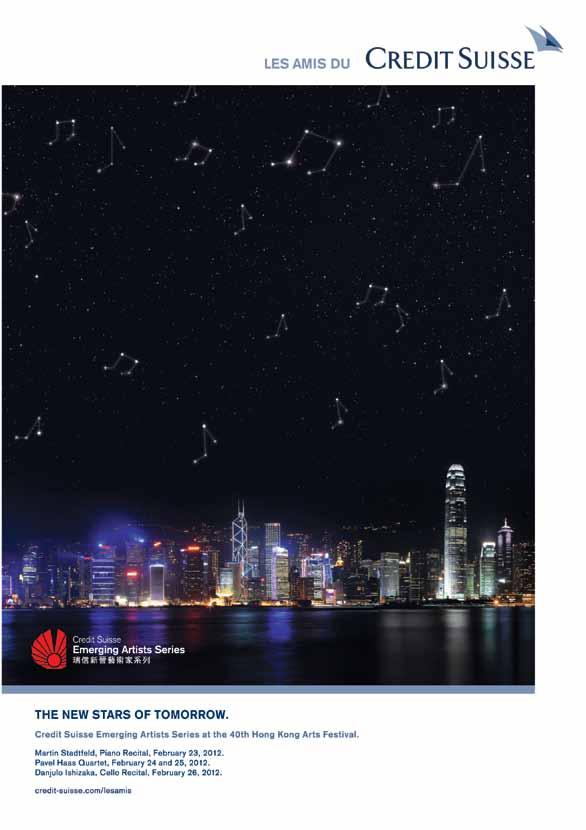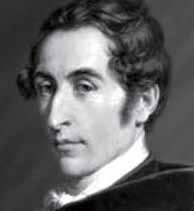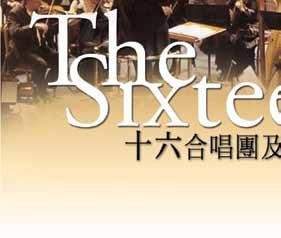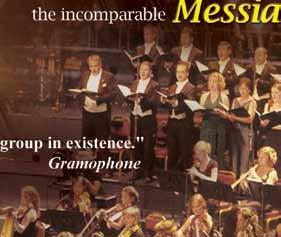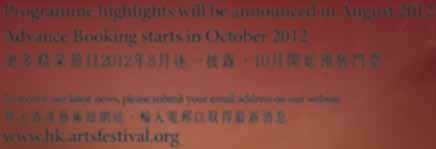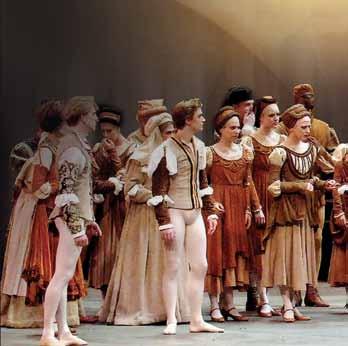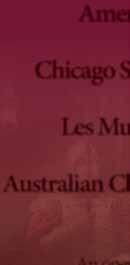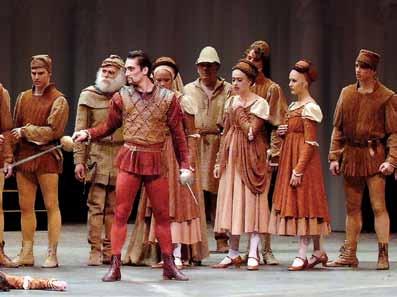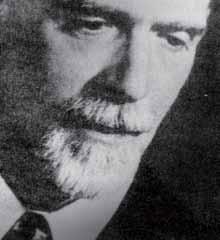Myung-whun Chung
指揮
Conductor
鄭明勳的音樂事業始於七歲時以鋼琴 家身份跟首爾愛樂樂團一同演出。
1974 年他在莫斯科獲得柴可夫斯基 鋼琴大賽二等獎。從紐約曼尼斯音樂
學院和茱莉亞音樂學院畢業後,他於
1979年加入洛杉磯愛樂樂團擔任指揮
家朱里尼的助理,兩年後升任為副指 揮。
1984至1990年間,他在德國薩爾布呂
肯電台交響樂團擔任音樂總監;1987
至1992年在佛羅倫斯市立劇院擔任首
席客席指揮;1989至1994年擔任法國
巴士底歌劇院音樂總監。2000年,他 回到巴黎擔任法國廣播愛樂樂團音樂 總監。鄭明勳在他熱愛的意大利工作
多年,包括1997至2005年在羅馬聖西 西利亞管弦樂團任首席指揮。
Myung-whun Chung began his musical career as a pianist, making his debut with the Seoul Philharmonic at the age of seven. In 1974 he won the second prize at the Tchaikovsky piano competition in Moscow.
In 1979, after completing his musical studies at the Mannes School and at the Juilliard School in New York, he became Carlo Maria Giulini’s assistant at the Los Angeles Philharmonic, and two years later he was named Associate Conductor.
He was Music Director of the Saarbrücken Radio Symphony Orchestra from 1984 to 1990, Principal Guest Conductor of the Teatro Comunale of Florence from 1987 to 1992, and Music Director of the Opéra de Paris-Bastille from 1989 to 1994. The year 2000 marked his return to Paris as Music Director of the Orchestre Philharmonique
除了歐洲的工作外,他也參與多項在亞 洲的音樂及社會事務,當中包括在東京 愛樂樂團擔任音樂顧問,並於2006年 起擔任首爾愛樂樂團的音樂總監。
他幾乎指揮過全世界的頂尖樂團,包 括所有倫敦和巴黎的主要樂團、柏林 愛樂樂團、維也納愛樂樂團、皇家阿 姆斯特丹音樂廳樂團、史卡拉愛樂樂 團、巴伐利亞電台交響樂團、德累斯 頓國家樂團、波士頓交響樂團、芝加 哥交響樂團、大都會歌劇院樂團、紐 約愛樂樂團、克里夫蘭管弦樂團及費 城樂團。
他自1990年起成為德意志留聲機唱片 公司的專屬藝人,灌錄了多張贏得無 數國際獎項的唱片。鄭明勳的藝術成 就為他帶來多項國際殊榮,包括意大 利阿比艾蒂獎和托斯卡尼尼獎;1991 年他獲法國劇院協會與樂評協會評選 為「年度藝術家」,1992年獲法國榮 譽軍團勳章,以及在1995年三度獲頒 法國音樂之光大獎。2011年,他獲法
國政府頒發藝術及文學勳章。
de Radio France. His love for Italy has been at the basis of his extensive work there for many years, including, from 1997 to 2005, his position as Principal Conductor of the Santa Cecilia Orchestra in Rome. Outside Europe, he has been increasingly committed to musical and social causes in Asia through his role as Music Advisor of the Tokyo Philharmonic Orchestra and, from 2006, Music Director of the Seoul Philharmonic Orchestra.
He has conducted virtually all the world’s leading orchestras, including all the major London and Parisian Orchestras as well as the Berlin Philharmonic, the Vienna Philharmonic, the Royal Concertgebouw, Filarmonica della Scala, Bavarian Radio Symphony Orchestra, Staatskapelle Dresden, Boston Symphony, Chicago Symphony, the Metropolitan Opera, the New York Philharmonic, the Cleveland and Philadelphia Orchestras.
An exclusive recording artist for Deutsche Grammophon since 1990, many of his numerous recordings have won international prizes and awards. He has been the recipient of many honours and prizes for his artistic work, including the Premio Abbiati and the Arturo Toscanini prize in Italy and the Légion d’Honneur (1992) in France; in 1991, the Association of French Theatres and Music Critics named him Artist of the Year and in 1995 he won the Victoire de la Musique prize three times. He was named a Commandeur dans l'ordre des Arts et des Lettres by the French government in 2011.
桑妮.恩遜
Janine Jansen
小提琴 Violin
桑妮.恩遜與皇家阿姆斯特丹音樂廳
樂團、芝加哥交響樂團、費城樂團、 克里夫蘭管弦樂團、倫敦交響樂團、 馬勒室樂團、日本放送協會交響樂
團、柏林愛樂樂團和紐約愛樂樂團經 常合作。曾與她合作的傑出指揮家包
括馬利斯.楊遜斯、羅連.馬捷爾、
維萊里‧格杰夫、列卡度.沙爾、賈 維父子、薩洛寧、丹尼奧.哈汀、艾 度.迪華特、古斯塔沃.杜達梅爾及
雅尼克.涅傑瑟貢。
Janine Jansen works regularly with the Royal Concertgebouw, Chicago Symphony, The Philadelphia, Cleveland, London Symphony, Mahler Chamber and NHK Symphony orchestras, as well as the Berliner Philharmoniker and New York Philharmonic. She has collaborated with several eminent conductors including Mariss Jansons, Lorin Maazel, Valery Gergiev, Riccardo Chailly, Neeme and Paavo Järvi, Esa-Pekka Salonen, Daniel Harding, Edo de Waart, Gustavo Dudamel and Yannick Nézet-Séguin.
2011/12年度她成為倫敦威格摩爾音樂 廳和倫敦愛樂樂團的駐場演奏家,並 進行美國巡演。她將與皇家阿姆斯特 丹音樂廳樂團及鄭明勳一同到亞洲作 巡演,並與意大利聖西西利亞國立音 樂學院管弦樂團及指揮安東尼奧.帕 帕諾在歐洲巡演。
除了與樂團演奏協奏曲外,恩遜亦鍾 情於室樂演奏。今季她將參與一個 室樂表演計劃,在倫敦、柏林、阿姆 斯特丹、漢堡、多特蒙德、里昂和埃 因霍溫等歐洲城市演出二重奏、舒伯 特的弦樂五重奏及荀白克的《昇華之
夜》。她在荷蘭烏得勒支策劃籌辦年度 國際室樂節,並自1998年起參與柏林 愛樂光譜合奏團每季的室樂表演。她 的室樂合奏夥伴包括提鮑德、米沙. 麥斯基、朱利安.拉克林、伊塔瑪. 戈朗、馬丁.弗羅斯特、卡蒂雅、利 夫.奧維.安斯涅斯和托雷夫.席德 登。
2003 年9 月,恩遜獲荷蘭文化部頒發 荷蘭音樂獎,這是荷蘭藝術家的最高 榮譽。除此以外,她還三次奪得艾迪 遜古典公眾大獎(最近一次是 2010 年)、三項回聲古典大獎、德國唱片 樂評獎,以及2007年NDR音樂獎傑出 藝術成就獎。2008年,她憑個人成就
榮獲VSCD古典音樂獎;2009年5月, 她憑在英國的演出獲得 RPS 器樂演奏 大獎。
中譯︰葛欣
The 2011/12 season sees her undertake residencies at Wigmore Hall and with the London Philharmonic Orchestra (which includes a US Tour). She will tour Asia with the Royal Concertgebouw Orchestra and Myung-whun Chung, and Europe with the Accademia Nazionale di Santa Cecilia and Antonio Pappano.
In addition to her concerto performances Jansen is a devoted chamber musician. This season she will perform a chamber project that includes Schubert’s String Quintet and Schönberg’s Verklärte Nacht in addition to duo recitals in London, Berlin, Amsterdam, Hamburg, Dortmund, Lyon and Eindhoven. She established and curates the annual International Chamber Music Festival in Utrecht, Holland, and since 1998 has performed each season at the Berlin Philharmonie’s Spectrum Concerts series. Her chamber partners include JeanYves Thibaudet, Mischa Maisky, Julian Rachlin, Itamar Golan, Martin Fröst, Khatia Buniatishvili, Leif Ove Andsnes and Torleif Thedéen.
In September 2003, Jansen received the Dutch Music Prize from the Ministry of Culture — the highest distinction an artist can receive in the Netherlands. She has received numerous other awards including the Edison Klassiek Public Award three times (most recently in 2010), three Echo Klassik awards, the Preis der Deutschen Schallplattenkritik, as well as the NDR Musikpreis for outstanding artistic achievement in 2007. In 2008 she was given the VSCD Klassieke Muziekprijs for individual achievement and in May 2009 she received the RPS Instrumentalist Award for performances in the UK.
韋伯︰《自由射手》序曲
韋伯的《自由射手》(1821年在柏林 首演)扭轉了十九世紀歌劇的發展。
此劇根據民間流傳的鬼故事寫成,內
容圍繞魔法子彈和與魔鬼交易,而序 曲除了是全劇縮影,也經常獨立成篇 在音樂廳演出。劇中的場景刻劃令人
難忘,在序曲亦有所預示。在慢板 引子,劇中安寧的大自然背景(柔和 的圓號四重奏)與推動劇情的超自然 元素構成對比,令人毛骨悚然的顫音 代表「狼谷」(「鑄造子彈」一幕令 人顫慄,而這段音樂對華格納的影響 清晰可聞)。序曲主要部份速度快, 激動的樂段刻劃主角麥克斯的痛苦; 單簧管旋律象徵麥克斯堅決要娶為妻
的少女阿嘉蒂,隨著這個旋律響起, 代表挽回愛情的盼望。下一段描寫愛 情,音樂欣喜若狂。作曲家把這些元
素交織在一起,最後以C大調的尾聲結 束,愛情戰勝了邪惡。
Weber: Overture to Der Freischütz
Carl Maria von Weber altered the course of 19th-century opera with Der Freischütz which premiered in Berlin in 1821. The Overture, meanwhile, deftly encapsulates the music drama — essentially a folkghost story involving magic bullets and a bargain with the devil — with a foretaste of the opera’s memorable scene painting. It has gone on to have a life of its own in the concert hall. An adagio introduction contrasts the opera’s peaceful natural setting (a mellifluous quartet of horns) with the supernatural elements that drive its plot. Eerie tremolos signify the Wolf’s Glen (the frightening scene in which the bullets are cast, the music for which left a deep imprint on Wagner). In the Overture’s fastpaced main section, agitated strains depict the torment of the hero, Max, while the promise of redeeming love arrives in the clarinet melody associated with Agathe, the young bride Max strives to win. Following this is a passage of deliriously joyful love music. Weber weaves all of these elements together and concludes the Overture with a C major coda in which the power of love triumphs over evil.
韋伯 Weber
舒伯特︰B小調第八交響曲 第八交響曲和 C 大調第九交響曲是舒 伯特最有野心的作品(第九又名《偉
大》,也是他最後一首交響樂作品)。
第八與他前七首交響曲截然不同,是 他兩首小調調性的交響曲之一(另一
首是 C 小調第四交響曲, 1816 年寫 成)。第八的別名「未完成」雖然在 舒伯特逝世以後出現,但不該與他本 人英年早逝扯上關係。事實上,舒伯 特完成此曲的兩個樂章後還活了六 年,期間寫了許多優秀的大型作品。
由於有諧謔曲草稿存在,由此可推算 舒伯特大概不打算偏離古典交響曲傳 統的四樂章結構。有學者認為,由於 樂曲開端太宏偉壯麗,令舒伯特想不 出夠份量的終樂章來平衡第一樂章。
另一方面,舒伯特在完成現存兩個樂
章後數月染上梅毒,可能是罹患致命 疾病所產生的心理影響,令他痛苦得 不能把第八寫下去。
Schubert: Symphony No 8 in B minor
Along with his final, Great C major Symphony, the Unfinished reveals Schubert at his most ambitious. Remarkably different in scope from the symphonies preceding it, this is Schubert’s only symphony in the minor mode aside from the Fourth from 1816 (in C minor). The posthumous nickname Unfinished should not be associated with the tragic early death of its composer. In fact, Schubert lived on for another six years after setting aside the two perfectly complete movements of the Unfinished and completed numerous other full-scale masterpieces after it.
Sketches for a scherzo exist, so it is unlikely that Schubert intended to depart from the conventional four-movement plan of a classical symphony. Some scholars suggest that he couldn’t manage to conceive of a finale weighty enough to counterbalance the magnificent opening structure. In addition, a few months after writing the two extant movements, Schubert contracted syphilis. It is possible that the psychological associations of his devastating illness made it too painful for Schubert to resume work on the score.
He begins the opening movement in the shadowy gloom of B minor — a tonality Beethoven once labelled a “black key”. A mysterious motif, given pianissimo by basses and cellos, sounds from an abyss.
舒伯特 Schubert
第一樂章在B 小調的陰霾下開始(貝多
芬曾把B 小調稱為「黑色調性」)。大
提琴和低音大提琴以極弱力度奏出神 秘的動機,聲音彷彿由深淵傳出。這
段很有聽天由命的意味,但後來卻幻 化出各種不同面貌,令人縈繞於心。
舒伯特憑着焦躁不安的伴奏,把不安
的期待感延長,才由雙簧管和單簧管 奏出憂鬱的主題。舒伯特鋪排第二主 題時也採用相同手法:先是伴奏,然
後是大提琴的抒情主題。這個主題雖 然優美動人,但後來的發展卻揭示了 其剛烈的一面。音樂繼續開展,陰森
的開端動機重現,哀婉沉痛卻又避無 可避;悲涼之情,溢於言表。
第二樂章轉到E 大調,根據兩個主題寫
成:安詳虔誠的主旋律和由單簧管奏 出的對比主題。〈行板〉雖以微笑回
應第一樂章的陰鬱,但也偶有悲觀、
矛盾的痕跡,為舒伯特的抒情色彩加 添深度。《未完成》遲至1865年才首 演,那已是舒伯特逝世後差不多四十
年了。此後有幾位作曲家試圖把交響 曲「完成」,但即使如此,舒伯特的 兩個樂章雖是未完成作品的一部份,
卻仍能獨立成篇,效果獨一無二。
The apparently resigned air of this music is just one of several guises that will be heard in the haunting transformations to come. Schubert prolongs the sense of uneasy expectation by presenting a restless accompaniment before oboes and clarinets give shape to the melancholy main theme. Schubert repeats this pattern in presenting the famous second theme: we hear its accompaniment first, followed by the lyrical theme itself on cellos. Despite its beauty, Schubert reveals a more aggressive side to this melody in its later development. The full brunt of the tragedy comes to the fore as the movement unfolds and reaches its end with the grim, inescapable pathos of the opening motif.
The second movement shifts to E major and revolves around a serenely prayerful principal melody and a contrasting theme introduced by clarinet. The Andante offers a smiling response to the darkness of the first movement. Yet there are traces of darker, more ambivalent moods as well, adding depth to Schubert’s lyricism. The Symphony was given a belated premiere — in 1865, almost four decades after the composer’s death — and there have been several attempts to “complete” the work since then. Still, Schubert’s pair of movements make for a uniquely satisfying torso by themselves.
布拉姆斯:D大調第二交響曲
貝多芬的交響曲成就斐然,布拉姆斯 對箇中的重要性理解透徹。十九世紀 末,許多與布拉姆斯同期的浪漫派作 曲家認為,貝多芬的交響曲縱使成 就極高,但也代表交響曲已走進死胡 同,標題音樂或華格納所開創的革命 性樂劇才是出路。然而布拉姆斯一直 堅持把交響曲視為自立的樂種,致力 為交響曲注入生命力。他的力作第一 交響曲雖經多年掙扎才於 1876 年問 世,但樂曲大獲好評,令這位已屆中 年的作曲家信心滿滿。第二交響曲與 第一交響曲剛好相反:他1877年寫作 第二交響曲時速度快得驚人,全曲五 個月脫稿。而樂曲的整體格調也跟第 一的史詩式戲劇性迴異,時人更喜歡 把第二交響曲與貝多芬的田園交響曲 悠閒的抒情色彩相提並論。
然而正如布拉姆斯學者萊因霍爾德‧ 布林克曼所言,在某方面來說,第二 交響曲才是布拉姆斯真正「突破之
Brahms: Symphony No 2 in D
Brahms had a deep understanding of the true significance of Beethoven’s symphonic achievements. Many of his fellow romantics in the later 19th century felt this weighty past represented a dead end and that the future lay in programme music or in the revolutionary music drama being forged by Wagner. Yet Brahms remained determined to breathe new life into the symphony as a self-reliant genre. It took a lengthy struggle, over many years, to produce his First Symphony (unveiled in 1876). But that work enjoyed a success that reinforced the confidence of its composer, who had by now reached middle age. In striking contrast to the First, he wrote the Second Symphony with astonishing speed: all told, within about five months in 1877. The music’s overall character, moreover, veers away from the epic drama of its predecessor. It even inspired early comparisons with the relaxed lyricism of Beethoven’s Sixth Symphony, the Pastoral.
Yet in some ways, as Brahms scholar Reinhold Brinkmann has shown, the Second Symphony represents the true “breakthrough” work for Brahms — even more than the First. Instead of competing with Beethoven, here Brahms arrives at an intriguing combination of playfulness, passion and serenity, while a subtle undercurrent of melancholy adds a complex emotional layer to the score’s more obvious “pastoral” qualities. Certainly the Second
Brahms
作」。布拉姆斯在曲中巧妙地揉合了 嬉戲、激情、平靜等氣氛,樂曲表面 上展現極強的「田園氣息」,但微妙 的憂鬱感卻藏於深處,為樂曲添上複 雜的情感。布拉姆斯精通將素材加以 發展,處理手法出神入化,第二交響 曲正是好例子。樂曲開始時,大提琴 和低音大提琴奏出簡單的三音動機, 而曲中大部份主題都由這個動機衍生 而來。開端所呈現的基本情感對比, 在樂曲後段仍然繼續發展:一方面是 「田園元素」(木管樂與圓號),另 一方面是「憂鬱情懷」(不安的定音 鼓鼓聲,還有突然響起的低音銅管 樂)。第二主題仿似「搖籃曲」一樣 溫柔地搖擺,這個著名的旋律令對比 更形鮮明;而隨着樂章開展,作曲家 繼續將這種對比發揮得淋漓盡致。
在優美動人的〈慢板〉裏,憂鬱的暗 湧更為明顯。「田園」樂思在第三樂 章也十分突出,但現在變成開玩笑似 的。一段快速的插段兩次突如其來地 在第三樂章出現,打斷音樂的流動。 特別的是,第一至第三樂章都是安靜 地結束,為興高采烈、令人眼花撩亂 的終樂章作好準備。終樂章主題呼應 第一樂章開端的三音動機,然而現在 音樂變得很有衝勁,令三音動機的格 調也不同了。全曲最後數頁是布拉姆 斯最刺激、配器最精彩的樂段,興奮 歡欣,奪目耀眼,把憂鬱氣氛驅散得 一乾二淨。
樂曲介紹︰湯馬士‧梅
presents a splendid example of Brahms’s mastery of organic development. At the very start, cellos and basses play a simple motif of three notes that provides the seed for much of the work’s thematic material. In this opening Brahms also introduces the basic emotional contrast that will be worked out in the Symphony: the contrast between “pastoral” elements (woodwinds and horns) and a kind of “melancholy” (the unsettled rumblings from the timpani and the interruptions by the low brass). The famous, gently rocking “lullaby” of the second theme further heightens the terms of this contrast, which Brahms probes in depth as the movement unfolds.
The Second’s melancholic undercurrents gain prominence in the meltingly beautiful adagio, while a more playful version of the “pastoral” idea comes to the fore in the third movement, whose flow is twice interrupted by a swift interlude. Remarkably, the first three movements all end quietly, setting the stage for the giddy high spirits of the finale. Its main theme recalls the three-note motif that opened the Symphony; now, though, the driving momentum of the music gives it a new character. The Symphony’s final pages contain some of the most exciting and brightly orchestrated music Brahms ever composed as a deliriously joyful blaze chases away all hints of melancholy. Programme notes by Thomas May
E
高大宜 (1882-1967) Zoltán Kodály
《加蘭塔舞曲》 Dances of Galánta
孟德爾頌 (1809-1847)
Felix Mendelssohn
小調小提琴協奏曲,作品64 Violin Concerto in E minor, Op 64
熱情的甚快板 Allegro molto appassionato
行板 Andante
不太快的小快板─甚活潑的快板 Allegretto non troppo – Allegro molto vivace
小提琴 Violin
桑妮‧恩遜 Janine Jansen
中場休息 interval 14.2.2012
巴托克 (1881-1945) Béla Bartók
《樂隊協奏曲》 Concerto for Orchesta
〈序曲〉︰不太快的行板─活潑的快板 Introduzione: Andante non troppo – Allegro vivace
〈成雙成對的遊戲〉︰諧謔的快板 Giuoco delle coppie: Allegro scherzando
〈悲歌〉︰不太快的行板 Elegia: Andante non troppo
〈被打斷的間奏曲〉︰小快板 Intermezzo interrotto: Allegretto
〈終曲〉︰沉重有力─急板 Finale: Pesante – Presto
高大宜 Kodály
高大宜:《加蘭塔舞曲》 據高大宜憶述,他童年「最美好的七 年」都在加蘭塔度過。加蘭塔是匈 牙利一個小鎮,位於連接布達佩斯與 維也納的主要道路上,即今日的斯洛 伐克境內。在這裏,年幼的高大宜見 識了好些對他影響深遠的音樂,包括 鎮上樂隊演奏的音樂,即在當時被視 為帶「吉卜賽」色彩的音樂。多年後 (1933年),已經成名的高大宜獲邀 創作一首管弦樂曲,為布達佩斯管弦 樂團成立80 週年誌慶;成品《加蘭塔 舞曲》既是精練的管弦樂組曲,也是 他緬懷早年鄉村生活的作品。
高大宜是研究民間音樂的先驅,曾在 二十世紀初指導同胞兼友人巴托克, 教他如何走遍全國各地蒐集民歌。
《加蘭塔舞曲》的靈感來自一套匈牙 利民間舞曲集,這套曲集在1800年左 右重現於世,並在維也納結集出版。
整體來說,《加蘭塔舞曲》模仿徵兵 制度推行前的器樂舞曲,取其基本風
Kodály: Dances of Galánta
“The most beautiful seven years” of his childhood, Zoltán Kodály once recalled, were spent in Galánta, a small Hungarian town located along the main throughway between Budapest and Vienna, located in present-day Slovakia. It was there that the young boy encountered some of his formative musical experiences, including the town band playing what was considered Gypsy-flavoured music. Much later, in 1933, the now-famous Kodály was invited to write an orchestra piece to celebrate the 80th anniversary of the Budapest Philharmonic. This became the Dances of Galánta , a compact orchestral suite that also pays homage to the composer’s memories of long-ago village life.
A pioneer researcher in the area of folk music, Kodály had mentored his fellow Hungarian and friend Béla Bartók in methods of gathering folk songs from around the country in the early years of the 20th century. But for Dances of Galánta he turned for inspiration to a rediscovered collection of Hungarian folk dances that had been published in Vienna around 1800. Overall the suite imitates the basic style and structure of the instrumental dance music that evolved during the days before conscription, when Austrian recruiters would attempt to lure young Hungarians to join the army by enlisting local musicians and dancers to entertain them. This type of music — known as verbunkos — drew
格和結構。推行徵兵制度前,奧地利 的招募人員為了吸引匈牙利年輕人入 伍,特意邀請當地樂手和舞蹈員來款 待他們。這種稱為「維爾布恩格斯舞
曲」的音樂承襲自民間傳統音樂,基 本上以憂鬱的慢速引子與狂野活潑的 快速樂段構成對比。
高大宜把上述的形式重複數遍,五段 舞曲一氣呵成,全曲開端是個鬱鬱 寡歡的慢速引子,最後則是閃爍的尾 聲。作曲家彷彿刻意模仿民間樂器, 讓單簧管顯得尤其突出,負責交代主 要的舞曲主題,而這個主題曲在不同 的段落間以不同姿態重現。隨著舞曲 一段又一段的響起,誘人的節奏漸漸 成型,由多個不同的樂器組合奏出, 憂鬱的單簧管主題一次又一次的重 現。按照活潑的「維爾布恩格斯舞 曲」傳統,高大宜最後迅速令全樂團 進入狂熱,全速前進。
from folk traditions and involves a basic contrast between a slow-paced, melancholy introductory part followed by a wild, rousing fast section.
Kodály repeats this pattern several times as he presents a series of five dances which are framed by a moody slow introduction and a flashy coda. As if imitating a folk instrument, the clarinet is prominently featured, spelling out the main dance theme that recurs in varied forms between sections of the suite. An irresistible rhythmic figure takes shape in varied orchestral guises as the series of dances continues, while the melancholy clarinet theme returns again and again. In lively verbunkos tradition, Kodály eventually whips the entire orchestra into a frenzy that sets the pulse racing.
孟德爾頌 Mendelssohn
孟德爾頌︰E小調小提琴協奏曲
早在1838年,孟德爾頌已打算為小提
琴名家暨名師費迪南‧大衛寫作協奏
曲。兩人自少年時代已份屬好友;同 在萊比錫布業大廳管弦樂團工作過, 大衛是團長,而孟德爾頌則是音樂總 監。然而,創作計劃一直被其他工作 打亂,但最終孟德爾頌還是在1844年 9月完成全曲。創作期間,他與大衛保 持聯絡,討論有關技巧和如何平衡獨 奏者與樂團的問題。這種作曲家與演 奏者緊密合作的形式自此成為模範, 後來許多協奏曲也以相同方式寫成。
第一樂章那焦躁的激情是作曲家動筆 時已出現的構思,而且一直念念不 忘。他給大衛寫信道:「一首 E 小調 的(協奏曲)在我腦中響起,樂曲的 開端令我不得安寧。」雖然第一樂章 相對較長,但由於作曲家對比例有敏 銳的觸覺,同時還適切地把第一樂章 與其他樂章連接起來,因此全曲比例
Mendelssohn: Violin Concerto in E minor Mendelssohn intended as early as 1838 to write a concerto for violin virtuoso and teacher Ferdinand David, a close friend since his youth and concertmaster of the Leipzig Gewandhaus Orchestra, of which the composer was at the time music director. Other tasks intervened, but eventually Mendelssohn returned to his original plan, completing the score in September 1844. During the process he corresponded with David to work through aspects of technique and questions of balance between the soloist and the orchestra. Such a close collaboration between composer and performer set a pattern that has been repeated in the creation of numerous subsequent concertos.
The first movement’s restless passion was part of the original concept that haunted Mendelssohn from the start. “[A concerto] in E minor runs through my head,” he wrote David, “the beginning of which gives me no peace.” Despite the relative length of the opening movement, the Concerto benefits from Mendelssohn’s exquisite sense of proportion and cross-connection between the other movements. The centre of the rapturously lyrical Andante , for example, echoes the restlessness of this opening, which also returns transformed in the delirious energy of the finale.
The Concerto’s first gesture immediately draws us into the middle of its drama,
馭管弦樂效果的卓越能力、對比的戲
劇化處理,還有一絲不苟的匠心。
不為突出獨奏者,反而為整個樂團而 寫作協奏曲的意念後來被多位二十世
紀作曲家採用。從某方面說,這種做
法矯正了浪漫時期協奏曲的大明星個
人主義;但也可說成是巴托克復興了
巴羅克時期的協奏曲觀念,也就是所 謂的「大協奏曲」,讓不同的小型樂
器組與大型合奏團構成織體對比。當
然,現代樂團技巧高超、表達力強、
聲音層次分明,《樂隊協奏曲》也將
這些特色發揮得淋漓盡致。事實上,
樂器音色證明是此曲的重要一環,重 要性與其傳統的主題與發展模式不相 伯仲。
論結構,《樂隊協奏曲》可視為一首 五樂章的交響曲,以陰鬱沉思的情緒 開始,漸漸尋得出路,最後找到積極
的生活態度,喜氣洋洋。巴托克以他 最喜歡的拱形結構(不論順序看或逆 序看都一樣,如ABCBA格式)把各樂 章連在一起。作曲家把上述的情緒變 化與結構合而為一,因此慢速的第三 樂章就是悲劇的核心,前後都是較輕 盈的插段,而第一和第五樂章則篇幅 最長,速度最快。
第一樂章靠着「對比」來推動;慢速 引子過後的快板充滿喧鬧的對位。第 二、三、四樂章則各有千秋︰第二樂
章〈成雙成對的遊戲〉仿如諧謔曲, 成雙成對的樂器逐一響起,中段則是 銅管樂奏出的讚美詩。令人念念不忘
up by many other composers later in the 20th century — in some ways as a sort of democratic antidote to the superstar individualism of the Romantic concerto. But it could also be argued that Bartók revived the Baroque concept of the concerto — the so-called concerto grosso, which contrasts various smaller groups of instruments with the texture of the larger ensemble. And of course the Concerto for Orchestra also serves to showcase the virtuosity and expressive might of a modern orchestra and the glory of its layered sound. In fact instrumental timbre turns out to be just as important a dimension of this music as the more conventional model of themes and their development.
In formal terms, the Concerto can also be regarded as a symphony in five movements, beginning in a dark, brooding mood but finding its way to life-affirming triumph. Bartók combines this with one of his favourite patterns: an arch-like structure that appears the same in both directions (like the pattern ABCBA). Thus the slow third movement is the tragic centre and is surrounded by two lighter interludes, which in turn are framed by the two longest and fastest movements.
Contrast fuels the opening movement, in which a slow introduction is followed by an allegro crowded with furious counterpoint. Each of the three inner movements has a distinctive feature. The scherzo-like second, The Game of Pairs , presents
的〈悲歌〉在全曲中心,除了襲用慢 速引子的素材,還可聽到巴托克著名 的「夜樂」樂段。第四樂章〈被打斷 的間奏曲〉拿「單純的」民間音樂慣 用手法來借題發揮,又透過模仿,毫 不留情地諷刺蕭斯達高維契(他的第 七交響曲在二戰期間大受歡迎)。沒 完沒了地呼呼作響的弦樂和銅管樂號 角曲,把急板的終樂章推進至令人振 奮的結尾。
樂曲介紹︰湯馬士‧梅 中譯︰鄭曉彤
pairs of instruments in sequence, with a brass chorale as the trio. The haunting Elegia at the heart of the Concerto recalls material from the slow introduction and contains examples of Bartók’s famous “night music”. The fourth movement, Interrupted Intermezzo, plays with clichés of “innocent” folk music and incorporates a cruel parody of Shostakovich, whose Seventh Symphony had become a popular piece during the war years. Endlessly whirring strings and brass fanfares urge the presto finale on to its thrilling conclusion.
Programme notes by Thomas May
皇家阿姆斯特丹音樂廳樂團
Royal Concertgebouw Orchestra
首席指揮
Chief Conductor
Mariss Jansons
榮譽指揮
Conductor Emeritus
Riccardo Chailly
桂冠指揮
Conductor Laureate
Bernard Haitink
榮譽客席指揮
Honorary Guest
Conductor
Nikolaus Harnoncourt
第一小提琴 First Violin
*Vesko Eschkenazy, leader
*Liviu Prunaru, leader
Tjeerd Top
Marijn Mijnders
Ursula Schoch
Marleen Asberg
Keiko Iwata-Takahashi
Robert Waterman
Janke Tamminga
Tomoko Kurita
Henriëtte Luytjes
Borika van den Booren
Christian van Eggelen
Mirte de Kok
Junko Naito
Benjamin Peled
Nienke van Rijn
Valentina Svyatlovskaya
Michael Waterman
第二小提琴 Second Violin
*Henk Rubingh
Caroline Strumphler
Susanne Jaspers
Josef Malkin
Anna de Vey Mestdagh
Paul Peter Spiering
Petra van de Vlasakker
Herre Halbertsma
Marc de Groot
Arndt Auhagen
Amélie Chaussade
Sanne Hunfeld
Monica Naselow
Jane Piper
Eke van Spiegel
Annebeth Webb
Joanna Westers
中提琴 Viola
*Ken Hakii
Michael Gieler
Gert Jan Leuverink
Saeko Oguma
Roland Krämer
Guus Jeukendrup
Jeroen Quint
長笛 Flute
*Emily Beynon
*Kersten McCall
Julie Moulin
Mariya SemotyukSchlaffke
Eva Smit
Eric van der Wel
Ferdinand Hügel
Yoko Kanamaru
Edith van Moergastel
Vincent Peters
Jeroen Woudstra
大提琴 Violoncello
*Gregor Horsch
Johan van Iersel
Fred Edelen
Benedikt Enzler
Yke Viersen
Arthur Oomens
Daniël Esser
Sophie Adam
Chris van Balen
Jérôme Fruchart
Christian Hacker
Julia Tom
低音大提琴 Double Bass
*Dominic Seldis
Thomas Braendstrup
Jan Wolfs
Mariëtta Feltkamp
Ruud Bastiaanse
Carol Harte
Rob Dirksen
Georgina Poad
Olivier Thiery
小號 Trumpet
*Giuliano Sommerhalder
*Alexandre Baty
Hans Alting
Bert Langenkamp
Wim Van Hasselt
短笛 Piccolo
Vincent Cortvrint
雙簧管 Oboe
*Lucas Macías Navarro
*Alexei Ogrintchouk
Nicoline Alt
Jan Kouwenhoven
單簧管 Clarinet
*Jacques Meertens
*Andreas Sundén
Hein Wiedijk
高音單簧管 E-flat Clarinet
Arno Piters
低音單簧管 Bass Clarinet
Davide Lattuada
巴松管 Bassoon
*Ronald Karten
*Gustavo Núñez
Helma van den Brink
Jos de Lange
圓號 Horn
*Jasper de Waal
Peter Steinmann
Sharon St. Onge
Fons Verspaandonk
Jaap van der Vliet
Paulien Weierink-Goossen
巡演工作人員 Staff on tour
製作總監 Managing Director Jan Raes
藝術行政總監 Director of Artistic Administration
長號 Trombone
*Bart Claessens
*Jörgen van Rijen
Nico Schippers
次中音/低音長號
Tenor/Bass Trombone
Martin Schippers
低音長號 Bass Trombone
Raymond Munnecom
大號 Tuba
*Perry Hoogendijk
定音鼓 Timpani
*Marinus Komst
*Nick Woud
敲擊樂 Percussion
Mark Braafhart
Gustavo Gimeno
Herman Rieken
豎琴 Harp
*Petra van der Heide
Gerda Ockers
*首席 Principal
Joel Ethan Fried
統籌及製作經理 Manager Planning & Production
Frauke Bernds
公關及傳訊經理 Manager PR & Press
Anne Christin Erbe
巡演經理 Tour Manager Else Broekman
助理巡演經理 Assistant Tour Manager Manon Wagenmakers
人事經理
Personnel Manager
Harriët van Uden
樂譜管理員 Librarian
Douwe Zuidema
舞台經理 Stage Manager
Jan Ummels
舞台助理 Stage Hand Frans van der Starre
舞台技師/樂器運輸 Stage Crew/Instrument Logistics
Johan van Maaren
舞台助理 Stage Hand
Ton van der Meer
贊助人 PATRON
曾蔭權先生
The Honourable Donald Tsang Yam-kuen
永遠名譽會長
HONORARY LIFE PRESIDENT
邵逸夫爵士 Sir Run Run Shaw
執行委員會 EXECUTIVE COMMITTEE
主席 Chairman
李業廣先生 Mr Charles Y K Lee, GBM GBS JP
副主席 Vice Chairman
許仕仁先生 Mr Rafael S Y Hui, GBM GBS JP
義務司庫 H onorary Treasurer
李思權先生 Mr Billy Li
委員 Members
夏佳理先生 The Hon Ronald Arculli, GBS JP
紀大衛教授 Professor David Gwilt, MBE
查懋成先生 Mr Victor Cha
周永健先生 Mr Anthony Chow SBS JP
黃敏華女士 Ms Nikki Ng
李 義法官 The Hon Mr Justice Ribeiro
詹偉理先生 Mr James Riley
黃鳳嫺女士 Ms Gilly Wong
任志剛先生 Mr Joseph Yam, GBM JP
節目委員會 PROGRAMME COMMITTEE
主席 Chairman
許仕仁先生 Mr Rafael S Y Hui, GBM GBS JP
副主席 Vice Chairman
紀大衛教授 Professor David Gwilt, MBE
委員 Members
盧景文教授 Professor Lo King-man, MBE JP
毛俊輝先生 Mr Fredric Mao, BBS
譚榮邦先生 Mr Tam Wing-pong, SBS JP
姚 珏 女士 Ms Jue Yao
伍日照先生 Mr Daniel Ng
羅志力先生 Mr Peter C L Lo
白諾信先生 Mr Giorgio Biancorosso
榮譽節目顧問 Honorary Programme Advisors
高德禮先生 Mr Douglas Gautier
Dr Peter Hagmann
約瑟.施力先生 Mr Joseph Seelig
財務及管理委員會 FINANCE AND MANAGEMENT COMMITTEE
主席 Chairman
李思權先生 Mr Billy Li
委員 Member
梁國輝先生 Mr Nelson Leong
發展委員會 DEVELOPMENT COMMITTEE
主席 Chairman
查懋成先生 Mr Victor Cha
副主席 Vice Chairman
梁靳羽珊女士 Mrs Leong Yu-san
委員 Members
杜安娜女士 Mrs Igna Dedeu
白碧儀女士 Ms Deborah Biber
廖碧欣女士 Ms Peggy Liao
黃慧玲女士 Ms Whang Hwee Leng
顧問 ADVISORS
鮑 磊先生 Mr Martin Barrow, GBS CBE JP
郭炳江先生 Mr Thomas Kwok, SBS JP
李國寶博士 Dr The Hon David K P Li, GBM GBS JP
梁紹榮夫人 Mrs Mona Leong, SBS BBS MBE JP
名譽法律顧問
HONORARY SOLICITOR
史蒂文生黃律師事務所 Stevenson, Wang & Co
核數師 AUDITOR
羅兵咸永道會計師樓 PricewaterhouseCoopers
香港藝術節基金會
HONG KONG ARTS FESTIVAL TRUST
主席 Chairman
霍 璽先生 Mr Angus H Forsyth
管理人 Trustees
陳達文先生 Mr Darwin Chen, SBS ISO
梁紹榮夫人 Mrs Mona Leong, SBS BBS MBE JP
陳祖澤博士 Dr John C C Chan, GBS JP
www.hk.artsfestival.org
網上追蹤香港藝術節 Follow the HKArtsFestival on
職員 Staff
行政總監 Executive Director
何嘉坤 Tisa Ho
節目 Programme
節目總監 Programme Director
梁掌瑋 Grace Lang
副節目總監 Associate Programme Director
蘇國雲 So Kwok-wan
節目經理 Programme Manager
葉健鈴 Linda Yip
外展經理 Outreach Manager
梁偉然 Ian Leung
助理節目經理 Assistant Programme Manager
汪文鈺 Joy Wang
助理製作經理 Assistant Production Manager
蘇雪凌 Shirley So
節目主任 Programme Officer
李家穎 Becky Lee
市場推廣 Marketing
市場總監 Marketing Director
鄭尚榮 Katy Cheng
市場經理 Marketing Managers
周 怡 Alexia Chow
梁頌怡 Kitty Leung
鍾穎茵 Wendy Chung
助理市場經理(票務)
Assistant Marketing Manager (Ticketing)
梁彩雲 Eppie Leung
發展 Development
發展總監 Development Director
余潔儀 Flora Yu
發展經理 Development Manager
嚴翠芳 Josephine Yim
助理發展經理 Assistant Development Manager
陳艷馨 Eunice Chan
會計 Accounts
會計經理 Accounting Manager
陳綺敏 Katharine Chan
助理會計經理 Assistant Accounting Manager
曾愛明 Ming Jung
會計文員 Accounts Clerk
黃國愛 Bonia Wong
行政 Administration
行政秘書 Executive Secretary
陳詠詩 Heidi Chan
地址 Address: 香港灣仔港灣道2號12樓1205室 Room 1205, 12th Floor, 2 Harbour Road, Wanchai, Hong Kong
電話Tel: 2824 3555 傳真Fax: 2824 3798, 2824 3722 電子郵箱Email: afgen@hkaf.org
節目查詢(辦公時間內) Programme Enquiries (during office hours): 2824 2430
接待員 / 初級秘書 Receptionist / Junior Secretary
李美娟 Virginia Li
辦公室助理 Office Assistant
鄭誠金 Tony Cheng
職員 Staff (合約 contract)
節目 Programme
物流及接待經理 Logistics Manager
金學忠 Elvis King
製作經理 Production Manager
廖卓良 Liu Cheuk-leung
節目經理 Programme Manager
何玉凝 Amy Ho
助理節目經理 Assistant Programme Manager
陳采琦 Kathy Chan
項目經理 Project Manager
林慧茵 Jess Lam
藝術家統籌及項目經理
Artist Coordination and Project Manager
陳韻妍 Vanessa Chan
外展統籌 Outreach Coordinator
陳韻婷 Alyson Chan
外展主任 Outreach Officer
蔡樂庭 Vanessa Tsoi
外展助理 Outreach Assistant
陳慧晶 Ainslee Chan
節目及出版主任 Programme & Publications Officer
曾逸林 Zeng Yilin
技術統籌 Technical Coordinators
黎春成 Anthony Lai
陳寶愉 Bobo Chan
鄭潔儀 Catherine Cheng
陳詠杰 Chan Wing-kit
陳佩儀 Claudia Chan
何美蓮 Meilin Ho
出版 Publication
編輯 Editor
鄺潔冰 Cabbie Kwong
英文編輯 English Editor
魏卓華 Mikel Echevarría
助理編輯 Assistant Editor
陳楚珊 Sharon Chan
市場推廣 Marketing
助理市場經理 Assistant Marketing Manager
陳燕 Lilian Chan
市場主任 Marketing Officer
梁愷樺 Anthea Leung
票務主任 Ticketing Officer
關穎思 Catherine Kwan
客戶服務主任 Customer Services Officers
劉寶軒 Xanthe Lau
楊蘊楹 Flora Yeung
姜嘉敏 Joyce Keung
發展 Development
發展經理 Development Manager
譚穎敏 Myra Tam
Concert Hall, HK Cultural Centre
Grand Theatre, HK Cultural Centre
漢堡芭蕾舞團 《馬勒第三交響曲》
The Hamburg BalletThird Symphony of Gustav Mahler
Studio Theatre, HK Cultural Centre
Concert Hall, HK City Hall
琶音古樂團 L'Arpeggiata / Christina Pluhar
漢堡芭蕾舞團 《 慾望號街車》
The Hamburg BalletA Streetcar Named Desire
奈吉爾.甘迺迪演奏會 Nigel Kennedy Plays Bach
白建宇 - 拉威爾鋼琴獨奏
全集音樂會
Kun Woo Paik Plays Ravel
鄭明勳與皇家阿姆斯特丹
音樂廳樂團
Myung-whun Chung and the Royal Concertgebouw Orchestra
卡麗塔.馬蒂娜女高音獨唱會
Karita Mattila in Recital
約翰博士與Lower 911樂隊
Dr John & The Lower 911
里昂歌劇院芭蕾舞團 Lyon Opera Ballet
《愛之初體驗》 Journey to Home
香港藝術節委約及製作 Commissioned and produced by the HKAF
京劇—馬連良紀念系列 Beijing OperaA Tribute to Laosheng Master Ma Lianliang
Theatre, HK City Hall
《六月戀人》
June Lovers
香港藝術節委約及製作 Commissioned and produced by the HKAF
Star Hall, KITEC
Auditorium, Kwai Tsing Theatre
《藝裳奇幻世界》 World of WearableArt
Drama Theatre, HKAPA
Black Box Theatre, Kwai Tsing Theatre
Auditorium, Yuen Long Theatre
The Hong
《野豬》 The Wild Boar
《藝裳奇幻世界》 World of WearableArt
香港藝術節委約及製作 Commissioned and produced by the HKAF
《野豬》 The Wild Boar
京士頓玫瑰劇院 《不可兒戲》 Rose TheatreThe Importance of Being Earnest
琶音古樂團 L'Arpeggiata Christina Pluhar
新民謠.中國風 China Folk Rock
《野豬》 The Wild Boar
《示範單位》
徹卡奧維《手塚》
Sidi Larbi Cherkaoui TeZukA
《蜂》 The Bee
粵劇《搜書院》 Cantonese OperaSearching the Academy
Show Flat
香港藝術節委約及製作 Commissioned and produced by the HKAF
粵劇 — 折子戲精選 Cantonese OperaExcerpts of selected repertoires
香港賽馬會當代舞蹈平台系列 Hong Kong Jockey Club Contemporary Dance Series
十六合唱團及古樂團 — 基斯杜化士
The SixteenHarry Christophers
巴伐利亞國立歌劇院 《女人心》
Bavarian State Opera Così Fan Tutte
蒙地卡羅芭蕾舞團 《仲夏夜之夢》
Monte-Carlo BalletLe Songe
沙漠搖滾塔里溫 Tinariwen
巴伐利亞電台交響樂團
Bavarian Radio Symphony Orchestra
蒙地卡羅芭蕾舞團 《仲夏夜之夢》
Monte-Carlo BalletLe Songe
節目1 Programme 1
香港藝術節委約及製作 Commissioned and produced by the HKAF
香港小交響樂團
《如夢逝水年華》 Hong Kong SinfoniettaLa Valse Remembered
《示範單位》
Show Flat
《機器人幻想曲》 Sans Objet by Aurelien Bory
《4.48精神崩潰》 TR Warszawa Theatre 4.48 Psychosis
藝子與舞子 The Geisha of Gion
瑞信新晉藝術家系列 CREDIT SUISSE EMERGING ARTISTS SERIES
馬丁.史岱費爾德 鋼琴獨奏會 Martin Stadtfeld Piano Recital
巴維.哈斯四重奏 Pavel Haas Quartet
《山海經傳》 Of Mountains and Seas
香港藝術節委約及製作 Commissioned and produced by the HKAF
Symposium 大師班 Masterclasses 17/2 卡麗塔.馬蒂娜歌唱大師班 Karita Mattila Voice Masterclass 23/2 巴維.哈斯四重奏大師班 Pavel Haas Quartet Masterclass 25/2 《彌賽亞》工作坊 Messiah — Workshop 2/3 多米拿堤合唱團大師班
石坂團十郎大提琴獨奏會 Danjulo Ishizaka Cello Recital
埃克森美孚新視野 EXXONMOBILE VISION
周樂娉與周樂婷鋼琴二重奏音樂會 Chau Lok-ping and Chau Lok-ting Piano Duo Recital
香港賽馬會當代舞蹈平台系列 Hong Kong Jockey Club Contemporary Dance Series
節目2 Programme 2
香港藝術節委約及製作 Commissioned and produced by the HKAF
香港中樂團「樂旅中國VI」 Hong Kong Chinese OrchestraMusic About China VI
《布利斯托爾》
老域劇團
Bristol Old Vic Faith Healer
亞太舞蹈平台 Asia Pacific Dance Platform
多米拿堤合唱團 Chamber Choir Dominante 周樂娉與周樂婷鋼琴二重奏音樂會 Chau
法國北方布夫劇場彼得.布祿克的《魔笛》 Theatre des Bouffes du Nord - A Magic Flute
邵俊傑與友人敲擊音樂會 Louis Siu and Friends Percussion Recital
《布利斯托爾》
老域劇團
Bristol Old Vic Faith Healer
《香港式離婚》(重演) The Truth About Lying (Re-run)
多米拿堤合唱團 Dominante 《泰特斯》(2012) Titus Andronicus (2012)
香港藝術節委約 Commissioned by the Hong Kong Arts Festival
